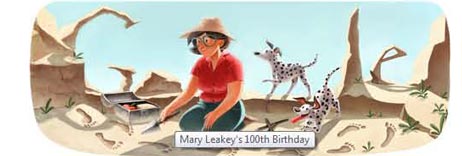Celebrating The Role of Women in Science
Today, Friday 8th of March is International Women’s Day, a day that is celebrated across the world, celebrating the achievements of women in business, the arts, politics and of course in the sciences. This is the one hundred and second International Women’s Day, in some countries this day is a national holiday.
International Women’s Day
In this brief article, we celebrate the work of women, past and present in the Earth sciences. It was very gratifying to see that last month, the Google Doodle acknowledged and celebrated the work of Mary Leakey. Mary was an English palaeoanthropologist who with her husband Louis made significant fossil discoveries helping scientists to understand the evolution of hominids including ultimately, our own species. Together, this husband and wife team proved that the birth place of human evolution was centred around the eastern part of Africa and that the human branch of the evolutionary family tree was much older than had been previously realised. The Google Doodle was put on line to mark what would have been her 100th birthday.
The Leakey family are still very much involved with Earth sciences. For example, Mary’s daughter Dr Meave Leakey, continues to study the origin of our species to this day and she is the co-leader of the world famous Koobi Fora Research Project in Kenya.
The Google Doodle Celebrating the Work of Mary Leakey
Picture credit: Everything Dinosaur/Google
Female Palaeontologists
In palaeontology, there are a great many female scientists, far too many to list but we pay our respects to them all and to those who championed the role of women in this particular branch of the sciences. In 1905, Marie Stopes a palaeobotanist become the first science lecturer at Manchester University, her expertise on fossil plants earned the University a world-wide reputation for being a centre of excellence for the Earth Sciences. Manchester University is today, the UK’s largest university and the Earth Sciences Department continues to contribute to the advancement of scientific understanding in a number of important areas.
Recently, BBC Radio 4 published a list of the top one hundred most powerful and influential women in the country. The work of a number of notable scientists was acknowledged. For instance, Professor Anne Glover, the first Chief Scientific Advisor to the European Commission was included in this list. Her role is to provide expert advice to the EU policy decision makers on subject areas that include science and technology.
Top 100 Women Power List
In the past, she has also been the Chief Scientific Advisor for Scotland. The first female Professor in the Engineering Department at the University of Cambridge, Ann Dowling also made the top 100 women of power list. It is always pleasing to see the work of women in science and engineering recognised in this way.
Closer to home, the first woman Vice Chancellor of the University of Manchester, Professor Dame Nancy Rothwell also made the top 100. Times have changed since Marie Stopes and her ground breaking role at the University. A Professor of Physiology, Dame Rothwell has had a very distinguished academic career as well as helping to run a number funding and medical research bodies.
High Profile Female Scientists
Forensic anthropologist Professor Sue Black also made the list. She is the director of the Centre for Anatomy and Human Identification at the University of Dundee. Her extensive knowledge has proved vital in the successful prosecution of a number of high profile criminal cases in the United Kingdom. She has also worked abroad, perhaps most notably in Kosovo where her knowledge of forensic anthropology helped to identify the victims buried in mass graves. Professor Black and her fellow scientists have helped to promote and encourage other women to take up a career in the scientific field.
Only a few days ago, a new scientific paper was published detailing the research into 360 million year old fossilised sea-lilies (crinoids) that had revealed evidence of organic biomarkers preserved in the fossil record. One of the authors of this research paper was Christina O’ Malley, a PhD student in Earth Sciences currently based at Ohio State University (United States).
To view the article on the research into biomarkers in crinoids: New Research Identifies Organic Biomarkers in 360-million-year-old fossils.
Acknowledging the Contribution
Today we acknowledge the work of women in palaeontology, the study of vertebrates including dinosaurs and in all aspects of scientific endeavour. It is important that we continue to enthuse and encourage girls to take up a career in the Earth Sciences. Tomorrow, March 9th marks the 166th anniversary of the death of Mary Anning. Mary was an amateur fossil collector who lived in Lyme Regis a town in Dorset, England, on what is now called the “Jurassic Coast”. We will always remember Mary’s contribution to palaeontology and we are happy to talk about her work and her role in the study of long extinct creatures, her story is an inspiration to young women hoping to embark on a career in the sciences.
As team member Sue might say, take a look at Everything Dinosaur’s website: Everything Dinosaur.




Leave A Comment